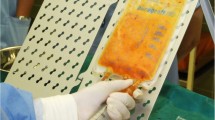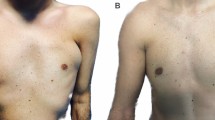Abstract
Background
Despite the advantages of autologous fat transfer to the breast, there are many complications after the surgery, such as oil cysts, calcification and palpable breast nodules. The fat purification process is a key step to reduce those complications, but there is currently no standard processing method. This study was designed to compare the incidence of fat necrosis after autologous fat grafting to the breast with low-speed centrifugation and sedimentation.
Methods
This study analyzed 100 patients (167 breasts) who underwent autologous fat grafts to the breasts from January, 2015 to March, 2017. Patients were divided into two groups randomly, low-speed centrifugation (800 r/min) and sedimentation (15 min). Postoperative fat necrosis such as oil cysts and palpable breast nodules was measured using physical examination and breast ultrasound 3 months after the surgery. The number and the diameter of the fat necroses were detected.
Results
A total of 100 patients (167 breasts) were included this research. There were 21 breasts with clinically palpable nodules (12.57%); fifteen (19.48%) were in the low-speed centrifugation group and six (6.67%) were in the sedimentation group (p < 0.05). According to postoperative breast ultrasounds, there were 83 breasts with hypoechoic cyst formations (49.7%); forty-five (58.44%) in the low-speed centrifugation group and 38 (42.22%) in the sedimentation group (p < 0.05). A positive correlation between the number of operative sessions and fat necrosis was found out.
Conclusion
Although low-speed centrifugation could achieve higher fat purification efficacy when compared with sedimentation, it causes more fat necrosis than sedimentation, such as clinically palpable nodules and subclinical nodules, especially in patients who had a history of breast surgery and those who needed more than one fat grafting session.
Level of Evidence III
This journal requires that authors assign a level of evidence to each article. For a full description of these Evidence-Based Medicine ratings, please refer to the Table of Contents or the online Instructions to Authors www.springer.com/00266.







Similar content being viewed by others
References
Chan CW, McCulley SJ, Macmillan RD (2008) Autologous fat transfer—a review of the literature with a focus on breast cancer surgery. J Plast Reconstr Aesthet Surg 61(12):1438–1448
ELFadl D, Garimella V, Mahapatra TK, McManus PL, Drew PJ (2010) Lipomodelling of the breast: a review. Breast 19(3):202–209
Szychta P, Zadrozny M, Rykala J, Banasiak L, Witmanowski H (2016) Autologous fat transfer to the subcutaneous tissue in the context of breast reconstructive procedures. Postepy Dermatol Alergol 33(5):323–328
Coleman SR (2006) Structural fat grafting: more than a permanent filler. Plast Reconstr Surg 118(3 Suppl):108S–120S
Kontoes P, Gounnaris G (2017) Complications of fat transfer for breast augmentation. Aesthet Plast Surg 41:1078–1082
Mineda K, Kuno S, Kato H et al (2014) Chronic inflammation and progressive calcification as a result of fat necrosis: the worst outcome in fat grafting. Plast Reconstr Surg 133(5):1064–1072
Sarfati I, van la Parra RFD, Terem-Rapoport CA, Benyahi D, Nos C, Clough KB (2017) A prospective randomized study comparing centrifugation and sedimentation for fat grafting in breast reconstruction. J Plast Reconstr Aesthet Surg 70(9):1218–1228
Gabriel A, Champaneria MC, Maxwell GP (2015) Fat grafting and breast reconstruction: tips for ensuring predictability. Gland Surg 4(3):232–243
Coleman SR, Saboeiro AP (2007) Fat grafting to the breast revisited: safety and efficacy. Plast Reconstr Surg 119(3):775–785 (discussion 786-7)
Khouri RK, Rigotti G, Cardoso E, Khouri RK, Biggs TM (2014) Megavolume autologous fat transfer: part II. Practice and techniques. Plast Reconstr Surg 133(6):1369–1377
Domenis R, Lazzaro L, Calabrese S, Mangoni D, Gallelli A, Bourkoula E, Manini I, Bergamin N, Toffoletto B, Beltrami CA, Beltrami AP, Cesselli D, Parodi PC (2015) Adipose tissue derived stem cells: in vitro and in vivo analysis of a standard and three commercially available cell-assistedlipotransfer techniques. Stem Cell Res Ther 6:2
Tissiani LA, Alonso N (2016) A prospective and controlled clinical trial on stromal vascular fraction enriched fat grafts in secondary breast reconstruction. Stem Cells Int 2016:12
Xie Y, Zheng D, Li Q, Chen Y, Lei H, Pu LL (2010) The effect of centrifugation on viability of fat grafts: an evaluation with the glucose transport test. J Plast Reconstr Aesthet Surg 63(3):482–487
Gutowski KA (2009) Current applications and safety of autologous fat grafts: a report of the ASPS fat graft task force. Plast Reconstr Surg 124(1):272–280
Tassinari JMD, Sisti AMD, Zerini IMD, Idone FMD, Nisi GMD (2016) Oil cysts after breast augmentation with autologous fat grafting. Plast Reconstr Surg 137(1):244e–245e
Rubin JP, Coon D, Zuley M et al (2012) Mammographic changes after fat transfer to the breast compared with changes after breast reduction: a blinded study. Plast Reconstr Surg 129(5):1029–1038
Khouri RK, Khouri RE, Lujan-Hernandez JR, Khouri KR, Lancerotto L, Orgill DP (2014) Diffusion and perfusion: the keys to fat grafting. Plast Reconstr Surg Glob Open 2(9):e220
Gause TM 2nd, Kling RE, Sivak WN, Marra KG, Rubin JP, Kokai LE (2014) Particle size in fat graft retention: a review on the impact of harvesting technique in lipofilling surgical outcomes. Adipocyte 3(4):273–279
Sunaga A, Sugawara Y, Katsuragi-Tomioka Y, Kobayashi E (2013) The fate of nonvascularized fat grafts: histological and bioluminescent study. Plast Reconstr Surg Glob Open 1(6):e40
Kato H, Mineda K, Eto H et al (2014) Degeneration, regeneration, and cicatrization after fat grafting: dynamic total tissue remodeling during the first 3 months. Plast Reconstr Surg 133(3):303e–313e
Eto H, Kato H, Suga H et al (2012) The fate of adipocytes after nonvascularized fat grafting: evidence of early death and replacement of adipocytes. Plast Reconstr Surg 129(5):1081–1092
Bilgen IG, Ustun EE, Memis A (2001) Fat necrosis of the breast: clinical, mammographic and sonographic features. Eur J Radiol 39(2):92–99
Rao A, Saadeh PB (2014) Defining fat necrosis in plastic surgery. Plast Reconstr Surg 134(6):1202–1212
Kurita M, Matsumoto D, Shigeura T et al (2008) Influences of centrifugation on cells and tissues in liposuction aspirates: optimized centrifugation for lipotransfer and cell isolation. Plast Reconstr Surg 121(3):1033–1041 (discussion 1042-3)
Cleveland EC, Albano NJ, Hazen A (2015) Roll, spin, wash, or filter? Processing of lipoaspirate for autologous fat grafting: an updated, evidence-based review of the literature. Plast Reconstr Surg 136(4):706–713
Pallara T, Signoretti M, Cagli B, Cogliandro A, Marangi GF, Persichetti P (2013) The volumetric analysis of fat graft survival in breast reconstruction. Plast Reconstr Surg 132(4):668e–669e
Khouri RK, Khouri RK (2017) Current clinical applications of fat grafting. Plast Reconstr Surg 140(3):466e–486e
Khouri RK, Rigotti G, Cardoso E, Khouri RK Jr, Biggs TM (2014) Megavolume autologous fat transfer: part II. Practice and techniques. Plast Reconstr Surg 133(6):1369–1377
Xie Y, Zheng DN, Li QF et al (2010) An integrated fat grafting technique for cosmetic facial contouring. J Plast Reconstr Aesthet Surg 63(2):270–276
Acknowledgements
The authors declare that we have no conflicts of interest to disclose.
Author information
Authors and Affiliations
Corresponding author
Rights and permissions
About this article
Cite this article
Kang, D., Luan, J. Fat Necrosis After Autologous Fat Transfer (AFT) to Breast: Comparison of Low-Speed Centrifugation with Sedimentation. Aesth Plast Surg 42, 1457–1464 (2018). https://doi.org/10.1007/s00266-018-1213-z
Received:
Accepted:
Published:
Issue Date:
DOI: https://doi.org/10.1007/s00266-018-1213-z




